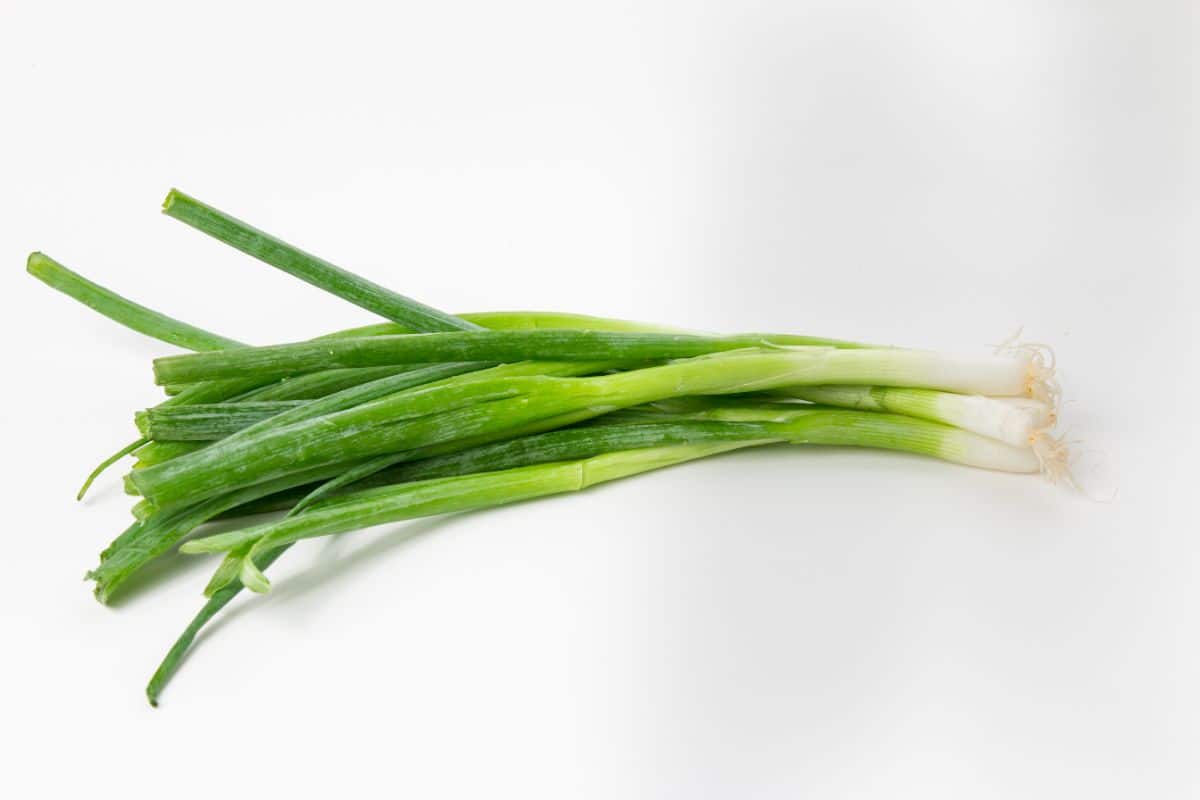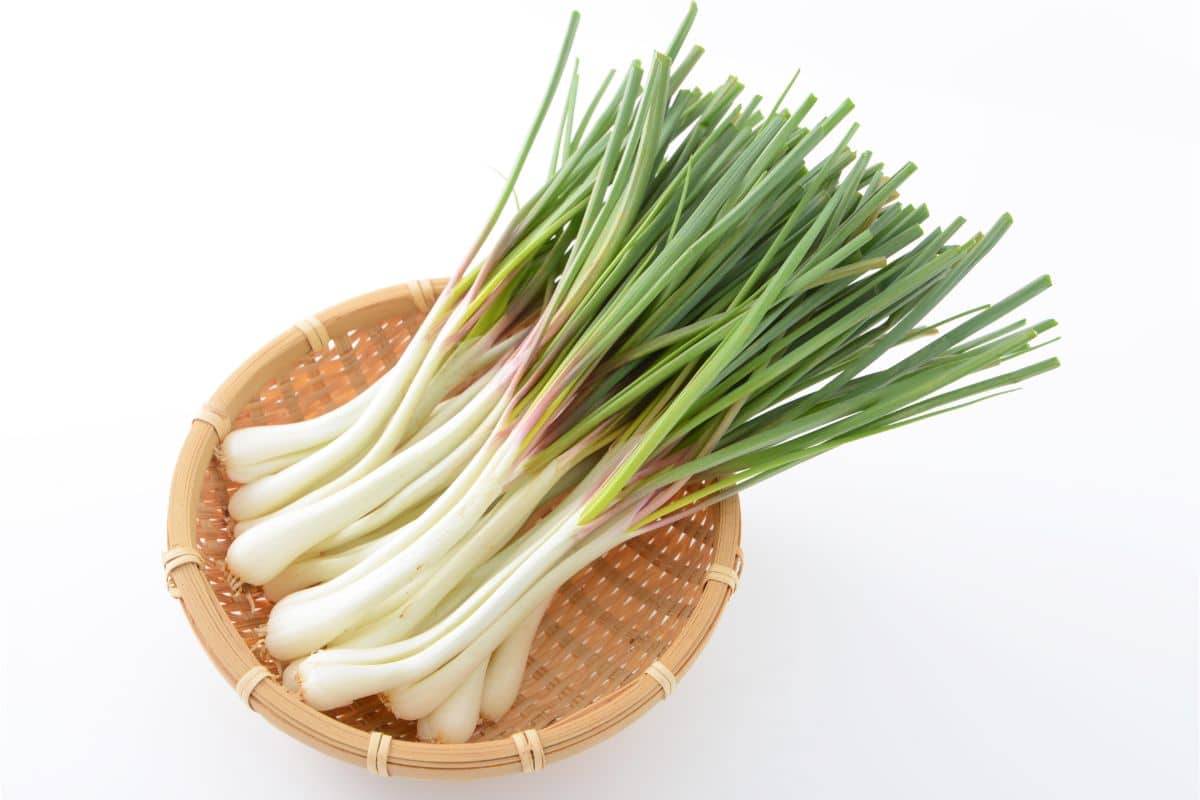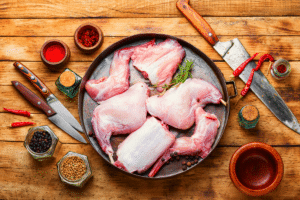Have you ever read a recipe and felt puzzled by seeing ‘scallions’ listed in the ingredients?

Scallions are often confused with other vegetables such as shallots, and they’re also known by the name ‘green onions’, which can lead to confusion.
If you’ve been asking yourself ‘What are scallions?’ then you’ve come to the right place.
In today’s guide, we’re going to be breaking down what scallions are, the nutritional benefits of this vegetable, and how they compare to other similar ingredients.
We’ll also be explaining how to use scallions for the best flavor.
Scallions: What Are They?
One of the most asked questions about scallions is, ‘What are scallions?’ So let’s answer that question first.
Scallions are also sometimes called spring onions, cybies, or green onions. They are part of the Allium genus, meaning that they are, indeed, a type of onion.
In terms of appearance, scallions have white bases that lead into green stalks that look very similar to chives.
The white base of the scallion is not fully mature, so it doesn’t have the bulb shape you would typically expect from an Allium.
You can consume scallions raw or cook them first, and both the green and white parts are edible.
With that being said, it’s more common to see the white part of the plant in cooked dishes, with the green stalks being used more often in raw dishes like salads.
Although scallions are mostly made up of water, they do provide some nutritional benefits in addition to flavor. A single scallion only contains 4.8 calories and doesn’t contain any fat.
There are only 1.1 grams of carbohydrates per medium scallion, with just 0.4 grams of sugar.
So, if you’re looking for low-calorie ways to add flavor to your food, scallions are a good choice.
Just bear in mind that these vegetables don’t provide much fiber or protein, with just 0.4 and 0.3 grams respectively per scallion.
Additionally, scallions contain vitamins such as vitamin K, vitamin B2, and vitamin C.
This means that flavoring your food with scallions may help to promote healthy bones and muscles while boosting your energy levels and metabolism and ensuring blood clotting.
The Difference Between Scallions And Green Onions
Many people are confused about the difference between green onions and scallions, but they are actually the same vegetable.
Some grocery stores will use the word ‘scallions’ on their packaging, whereas others will use ‘green onions’. That doesn’t mean there’s any difference between the two.
Since scallions and green onions are the same things, you can use products labeled with either of these words interchangeably. There’s no difference in the flavor or nutritional value.
Spring Onions Or Scallions?
The terms ‘scallion’ and ‘spring onion’ are frequently used interchangeably, and this can cause a lot of confusion because scallions and spring onions are actually not the same, although they are very similar.
Spring onions are harvested before they reach maturity, which means that compared to regular onions, they are significantly smaller. However, they are larger compared to scallions.
It’s not just size that differentiates spring onions from scallions. Spring onions produce more flavor than scallions.
While they can also be added to both cooked and raw dishes, you’ll notice that the flavor of spring onions is more potent, especially when eaten raw.
Comparing Shallots And Scallions
Shallots and scallions are also confused with one another quite often, although they look very different and also have quite different flavors.
The main similarity that scallions and shallots share is the fact that they both belong to the onion family.
However, shallots have a milder and sweeter onion-like flavor, which is why they’re such a popular ingredient for adding a hint of sweetness to savory dishes.
Like scallions, shallots can also be consumed raw or cooked. When cooked, one of the most popular ways to use shallots is in a stir-fry, although it is also a common ingredient in sauces and salads.
Chives Vs Scallions
It is important to know the difference between chives and scallions. Not only do these vegetables look different, but they taste different, too.
So, if you substitute one for the other, your dish could end up with a very different flavor.
The first thing to bear in mind is that chives have a milder flavor than scallions. They taste like onion, but it’s more subtle than the flavor of green onion.
You might see chives being used to garnish certain dishes like scrambled egg or baked potato. They are also delicious when mixed in with salads or soups.
If you’re looking for an alternative to scallions with more vitamins and antioxidants, you should consider adding chives to your cooking.
Chives contain vitamins C and A and are also rich in antioxidants, which may help to reduce inflammation in the body.
What To Use Instead Of Scallions
Don’t have any scallions to add to your favorite recipe? Don’t worry.

There are plenty of great scallion substitutes out there that pack a punch of flavor and can be swapped out without too much trouble.
Some of the best substitutes for scallions include the ingredients we’ve already compared scallions to in this article, such as:
- Spring onions. These vegetables have a similar texture to scallions, so you can use them instead without worrying about impacting the mouthfeel of your dish. Additionally, the flavor of spring onions is very similar to that of scallions. If you want to add an even more intense flavor to your recipe, consider grilling or pickling the spring onions first.
- Chives. You can’t really replace the white part of scallions with chives, but if you’re looking for a replacement for the green part, chives work well.
- Shallots. Although shallots are quite different from scallions in terms of texture and flavor, they’re a decent alternative if your goal is simply to add more onion-like flavor to a recipe.
- Leeks. Scallion whites can easily be substituted with leeks. This works best in cooked dishes. You can also replace the green part of the scallion with the leafy part of the leeks.
The Best Way To Prepare Scallions
Other than wondering what scallions are, another commonly asked question about this green vegetable is how to chop and prepare it for use in both raw and cooked dishes.
We find that the most practical way to prepare scallions involves cutting the vegetable in half so that the white part can be used for cooked dishes, and the green part for raw dishes.
However, this is entirely down to personal preference, and there’s no reason you can’t use the green part of the scallion in a cooked dish.
The idea of ‘chopping’ a scallion is actually the first hurdle when it comes to preparing green onions. That’s because it’s actually better to slice the scallion rather than chopping it.
The difference might not seem that significant, but chopping involves cutting in a straight downward motion, whereas slicing is a pulling movement that goes across the surface.
Here’s how to cut scallions the professional way:
- Start by rinsing your scallions using cold water. Then, use a piece of paper towel to dry them gently.
- If you notice any parts of your scallions that are wilted or brown, use a sharp knife to trim them, taking care not to take too much of the green part away with the brown.
- Using the same sharp knife, cut the scallion roughly ¼ inch from the base. Then, holding the scallion from the top, cut through the vegetable so that the white part is separated from the green part.
- Begin slicing the white part, using a smooth, dragging motion to slice the vegetable into thin circles.
- Repeat the slicing process with the green part of the scallion, but this time, try to slice diagonally. Keep the slices thin, especially if you’ll be adding the green of the scallion to an uncooked dish.
Final Thoughts
Scallions and green onions are the same thing, but it’s important to differentiate between scallions and spring onions, shallots, and chives, since these are all different vegetables.
Scallions are part of the Allium genus and are great for adding flavor to both raw and cooked dishes thanks to the differences in flavor and texture between the white and green part of the onion.
You can easily substitute scallions with chives, shallots, or spring onions, depending on the flavors you want for your dish.
Just remember to slice, rather than chop, scallions for the best results in the kitchen, and try to use the whole of the vegetable.
Frequently Asked Questions
Yes, it is a good idea to use the whole green onion or scallion while cooking.
Many people discard the white part of the scallion, even though this part is very flavorful and can be used to add extra potency to cooked dishes.
You can even make an effort not to waste scallion roots. These can be used to make stocks, or even composted to turn into plant fertilizer.
Using the whole scallion will save you money and reduce your food waste.
Because scallions are very versatile, they can be added to a wide range of recipes. One of the most popular ways to use uncooked scallions is to add the green part to potato salad.
We also like to add sliced scallions to cauliflower soup.
All kinds of salads, soups, and stews can benefit from the addition of some scallions. We also recommend adding some to fried rice dishes, such as egg fried rice and hibachi fried rice.
If you’re worried about not being able to use all your scallions before they go bad, the good news is that you can freeze scallions for up to 4 months.
You will need to store them in an airtight container such as a sealable freezer bag to stop any air from getting to the scallions.
If you do this, they should retain their flavor for a minimum of 3 months,
Spring onions are the most similar to scallions in terms of appearance and flavor.
Like scallions, spring onions have a white part and a green part, which means that you can replace scallions with spring onions in any recipe, cooked or raw.
Just bear in mind that the white parts of spring onions are typically more pungent than the white parts of scallions, so you may want to adjust the quantities if substituting this part.
Yes, scallions are good for you because they provide many nutritional benefits. The most important thing is that scallions contain antioxidants, which means they are anti-inflammatory.
That means they can help to reduce inflammation in the body, which might lower your risk of diseases such as cancer. Additionally, scallions contain several essential vitamins.
It’s also thought that because scallions contain fiber, they might improve digestion and reduce symptoms of digestive issues, such as bloating.
With that being said, if you have an allergy to another member of the Allium genus, it’s wise to be cautious when trying scallions.
That’s because, in some people, scallions and other kinds of onions can trigger allergy symptoms, ranging from a runny nose and itchy eyes to asthma and a rash.
If you are experiencing these symptoms after eating scallions, you should look for another flavorful alternative.






